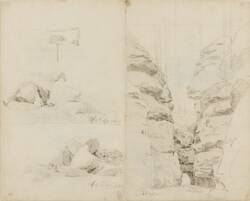The Utterwald Grund gorge in Saxon Switzerland is reached through a rock arch created by fallen sandstone rocks wedged between the gorge’s narrow sides. Today, this is a popular place for a day out. In Caspar David Friedrich’s time, though, it was somewhere he still found solitude. He wrote to a friend, the Russian poet Vasily Zhukovsky: “Once I stayed for an entire week in the gorge at Uttewald Grund between the rocks and pine trees, in the entire time I never met another living person. Truly, I would not recommend this method to anyone – and even for me, it was too much: involuntarily, a gloom descended on my soul.”
Yet at the same time, he also needed this solitude: “I must stay alone and know that I am alone to contemplate and feel nature in full; I have to surrender myself to what encircles me, I have to merge with my clouds and rocks in order to be what I am.”
During these days, he executed the study of the rock bridge you can also see here. Later, he took the same motif for this sepia landscape. In this case, he did not compose the work from several unconnected studies, as was so often the case. Instead, he scaled up his drawing of the gorge directly on the sheet for his sepia painting. We see a view from the north, the same as hikers still see today. On the other side of the rock bridge, Friedrich sketched two figures against the light. Perhaps he imagined a passage there out of the soul’s darkness after his lonely days in the gorge.
Further Media
- Location & Dating
- around 1801
- Material & Technique
- Brush over pencil on vellum
- Museum
- Museum Folkwang, Essen
- Inventory number
- Museum Folkwang, Essen, lnv.-Nr. C 21/36
